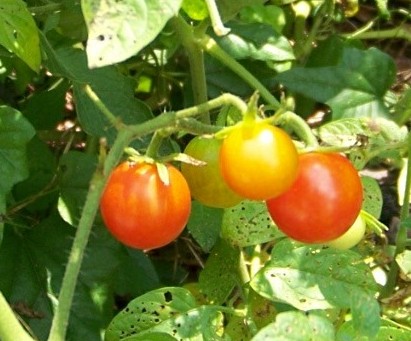|
Gardens Ablaze |
||
|
|
Tomato Problems
- Pests & Diseases |
|
|
Detailed Vegetable Profiles Site Map
Home
|
Tomatoes are basically easy and rewarding to grow, and many of us get through a season with no problems whatsoever. Good gardening practices, regular crop rotation, and companion planting are preventative measures that will go a long way in reducing pests and disease. Other simple measures include amending the soil with compost regularly, keeping the garden weed free, mulching, providing adequate water during dry spells, spacing the plants far enough apart to allow for air circulation, and using disease-resistant tomato varieties (That's the VFN or VFNT you see on the little tag - V=Verticillium Wilt, F=Fusarium Wilt, N=Root Knot Nematodes, and T=Tobacco Mosaic Virus - see below for more information on these). Of all the problems I hear about from home gardeners regarding tomatoes, blossom end rot is probably the most prevalent. Symptoms include a water-soaked looking area on the blossom end (or bottom) of the tomato that eventually turns black and leathery, and develops a sunken appearance, rendering the fruit useless. Variations in temperature and fluctuations in water are thought to cause blossom end rot, and the problem is usually more prevalent in the first half of the growing season when the weather and rain are at their most volatile. Maintaining a soil Ph of about 6.5 is a good preventative measure, and adding a little lime or crushed eggshells around the roots of affected plants can be of benefit, as the base cause of blossom end rot is a lack of uptake of calcium by the plant due to the fluctuations in temperature and water described above. Again, good gardening practices are the best preventative measure, so be diligent about weeding and mulching to keep the soil moisture and temperature constant, and be careful not to cultivate too deeply because you don't want to disturb the root system. The good news with this particular tomato problem is that once you pick off the bad fruit and solve the underlying problem, the tomato plant will likely go on to develop a bumper crop of beautiful, unaffected tomatoes. The second most prevalent problem I hear about is tomato hornworms. You will know it if a tomato hornworm is at work in your tomato patch, because your beautiful plants will suddenly begin disappearing before your eyes! These caterpillars are huge - 3-4 inches when full grown, and are a light green with eight diagonal usually silver-toned markings - overall making them blend well with tomato foliage. These caterpillars have a green or reddish horn protruding from their back ends (thus the name hornworm). They are voracious eaters and in late summer will even feed on the tomatoes themselves, doing serious damage to both the plant foliage and the fruits. The best defense for the home gardener is to keep a watchful eye on your plants, and hand pick any hornworms you find. Preventative measures can include companion planting, with Dill, Borage, Marigold, Petunia, Pot Marigold, and Basil (especially Opal Basil) all widely accepted companion plants for thwarting of tomato hornworms. Environmentally safe insecticides such as Bt (most commonly sold as Dipel) can be used in severe cases, but this is usually not necessary in a home garden situation, and any insecticides should be used only as a last resort. OTHER TOMATO PROBLEMS Early Blight:
Despite the misleading name, early blight affects mature plants and
foliage, at first causing irregular brown spots on lower leaves which enlarge
over time, often forming concentric rings or a "bulls eye" pattern on the
infected leaves, usually with a thin yellow halo around the lesion.
The disease is capable of moving up the stem, and if severe, can defoliate
the entire plant, also infecting the fruits by causing a sunken, blackened
spot near the stem end of the fruit. This disease is caused
by a fungus and can happen at any time during the growing season.
Good gardening techniques such as keeping weeds at bay, watering from below
without wetting the leaves, and mulching will help keep the tomato patch
free of this disease. However, if you do find that it is present in
your tomatoes, a biofungicide or fungicidal soap (Gardens
Alive! Gray Mold: Aptly named, gray mold is another fungal problem for both greenhouse and field tomatoes. It starts in cool, damp weather as gray or tan spots on the leaves, flowers, or fruits, and then progresses until the host finally withers completely, and a gray felt-like coating covers it. Often, when disturbed, the fungus spores will rise in a cloud to be carried off by the wind, making it quite destructive due to its ease of travel. Though you probably didn't realize it, gray mold is the same stuff that you see on those 3 week old strawberries you forgot about in the refrigerator. Once a plant is infected, there's little that can be done to save it, but good cultural practices can go a long way in preventing it in the first place. Providing good air circulation, watering regularly from below to minimize plant stress, keeping the area weed free, mulching, and collecting fallen leaves regularly should ensure a good tomato harvest with few problems with gray mold.
Custom Search
|
|
|
Gardens Ablaze |
||
 I
get a lot of questions from readers about vegetable gardening all year long,
but in the summertime, tomatoes top the list 10 to 1.
I
get a lot of questions from readers about vegetable gardening all year long,
but in the summertime, tomatoes top the list 10 to 1.